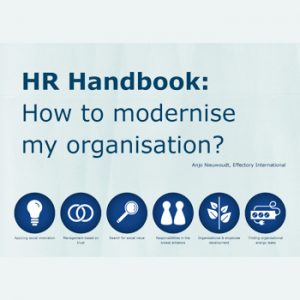Every week I speak to different CEOs in different boardrooms. From high-tech companies to healthcare institutions, stores and service companies. And no matter how different their organizations are, they have similar concerns.
Talent, Agility, and Innovation

1. How do we stay innovative?
Technological developments such as robotization, augmented reality and artificial intelligence (AI) offer new opportunities in all kinds of areas. But CEOs fear that their organization ignores important technical trends, neglects innovation and is eventually overtaken by promising start-ups. Which means that one day it is suddenly too late to change course.
Because that is what happens. Think of Nokia, Kodak, OAD and V&D. These companies failed to innovate year after year. Their decline was a creeping, almost invisible process. Until the unimaginable happened.
The biggest nightmare for CEOs is to wake up one day in a similar situation. They wonder: how do we constantly stay one step ahead of the competition? How do we respond quickly and creatively to new developments? How can we maintain our leadership in a digital world?
2. How do we stay agile?
Change is a constant, but the speed of change is increasing. Many CEOs are wondering: can our organization keep up? Are we enterprising enough? Do we respond quickly enough to developments in the outside world? Like technical breakthroughs, demographic shifts and concerns about climate change. Or is our organization too bureaucratic, too rigid and too syrupy to turn the helm in time?
CEOs are looking for ways to stay agile. They wonder: should we scrap management layers? Or maybe even switch to something like self-management? They are prepared to do a lot to prevent their organization turning into a fossil, an unmaneuverable company.
Free HR Handbook: How to modernise my organisation?
How to modernise my organisation?" provides practical HR tips to get started. You will discover how your organisation can be sustainable successful.
Download3. How do we recruit and retain talent?
Creative talents are indispensable for innovation. But then that talent must want to be employed by you. CEOs wonder: how do we remain interesting for creative minds who come up with original angles and surprising solutions? Who combine an entrepreneurial mentality with customer focus and excellent people skills. How do we stay employer of choice for these people?
Many organizations are also struggling with high turnover. Turnover is expensive: to replace an employee, you not only pay recruitment costs, training costs and costs for onboarding. You also suffer productivity losses during the months of the induction period. And lose revenue in the period when no one is in the post. It is easily an annual salary of extra costs per departing employee. A high turnover is therefore a real headache for every CEO.
Speak the language of CEOs
Human Resource Management departments have very specific questions. They have to attract talent to work for the company in a tight labour market. This requires creative recruitment methods, such as collaborating with technical training courses and actively approaching high potentials. Often, however, the time or budget is lacking.
If you want to explore new recruitment methods, if you finally want to digitize HRM tasks properly so that you at least arrive at your strategic task, present it as what it is: as an essential contribution to the strategic issues facing the organization.
Agility
Human resource management departments are concerned about how they can offer new development opportunities and challenges to established employees.
If you want to set up a program for continuous learning, make the link between agility and innovative capacity. If you want to invest in employee research and make use of social innovation, then emphasize that this ensures talent retention and being an employer of choice. It ensures that your entrepreneurship, service orientation and the motivation of your staff are quickly increased.
The right organizational culture
Human Resource Departments are working hard to position the organization attractively with smart employer branding and to stimulate the right organizational culture.
If you are unsure whether the official company mission is appealing enough to mention in job ads, say it how it is: organizations that contribute to a better world through word and deed are more often the employer of choice.
If you want to stimulate a culture where employees are given ample room to develop and come up with new project proposals, then point out that growth and variety are basic needs for talents.
Commitment and passion
Human Resource Management departments know that commitment and passion are important indicators for keeping employees motivated for the longer term.
If you want to use pulse research to gain insights into how employees view internal changes, so that you can intervene if employees become demotivated, emphasize involvement and passion as the most important steering variables to reduce turnover.
Use the power of tech and touch
To remain innovative and agile you need talents that are involved and passionate. This is evident from our meta-analysis of feedback data from tens of thousands of organizations at home and abroad in recent decades. And that is what Human Resource Management departments know and experience.
If you speak in the language of your CEO, you will notice that you find a willing ear in the boardroom. And then you can really help your organization.
Employee Engagement
Increase employee engagement through action-oriented feedback. Using a single platform, you can collect reliable data, analyze the results, and share insights.
view employee survey solution